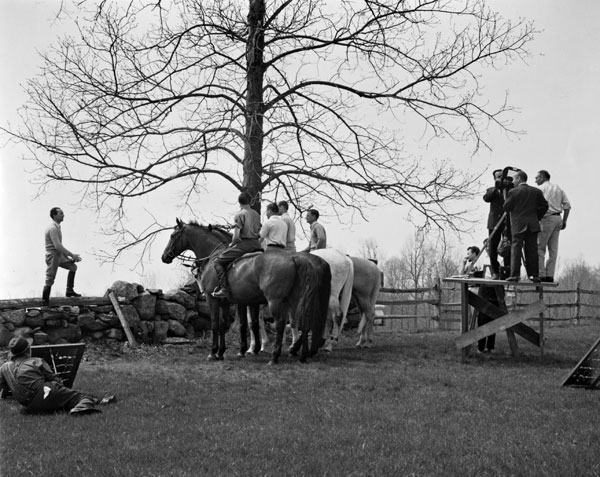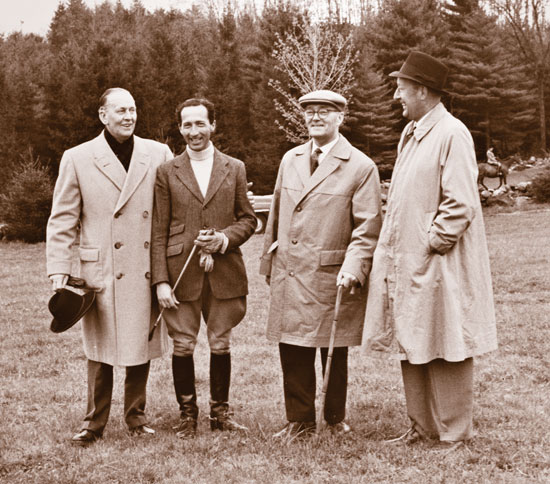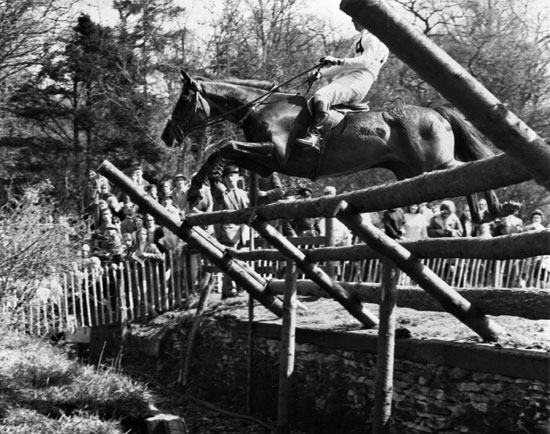Olympic Team In Its Preliminary Phase
John T. Cole, Colonel, Cavalry
March 19, 1948
We should like to take this opportunity of expressing our appreciation of the backing our sportsmen have given us. The response of individuals, racing associations, and the Professional Horsemen’s Association has been most gratifying.
Through the efforts of Mr. J. Spencer Weed and Mr. J. Brooks Parker, the Special Warfare Fund, the U. S. Army Equestrian Team has reached the halfway mark to insure our riders every chance to make good in the Olympics. It is recognized that this effort cannot be taken from the taxpayer’s pocket. It must come from those who insist on having American horsemen on a par with the rest of the world.
In all, 10 officers, including the veterinarian, Lt. Col. Harvie Ellis, 11 enlisted men and 31 horses have made the trip. In addition to Col. E.F. Thomas, Team Captain, Col. A.A. Frierson, Col. F.F. Wing, Lt. Cols F.S. Henry, C.A. Symroski, C.A. Anderson, Capts. J.W. Russell, J.R. Burton, and Lt. R.J. Borg, are the other riders on the team. In Europe, Col. Thomson picked up Maj. J.P. Owens, theater remount officer, who literally knows every horse in Germany by name.
Upon arrival, the team has gathered up some 17 horses. Five came from the stables of the S.S. Infantry division in Italy.
The other horses located came from the vast numbers owned by the German Army and S.S. Troops during the war years.
As now constituted, the team is working 13 three-day horses, 31 jumpers and four dressage prospects. It is expected the team will be joined by Col. H.E. Tuttle, USA, retired, and one or two dressage horses.
A recent letter from Col. Thomson indicates that they are nicely settled. They are working at the Munich-Reim racetrack—adjacent to the Munich Airport.
Col. Thompson wasted no time looking up past German riding masters. Through Von Nagle, whom many may remember as the rider of Dido and Wotan years ago, he found the dressage experts to utilize both for
dressage work on his purely dressage horses and also on his three-day men.
[In the 1948 London Olympics, the U.S. teams earned gold in eventing and silver in dressage, while the show jumping team was eliminated. Col. Frank S. Henry earned the individual silver in eventing.]

| In 1960, USET show jumping riders took time off from training to work with producer-director Larry Lansburgh (extreme right) in filming the movie The Horse With The Flying Tail. Team coach Bert de Nemethy (left) is shown with USET members George Morris, Frank Chapot, William Steinkraus, and Hugh Wiley, the owner-rider of Nautical. |
To Directors And Members Of U.S. Equestrian Team Inc.
Jan. 24, 1958
At the recent (Dec. 3) meeting of the Executive Committee of the U.S. Equestrian Team, a far-reaching decision was made.
Grand Prix Jumping Group
A. Winter in Tryon, N.C., 1957-58. There, the experienced horses will rest and keep healthy with light work. The new young ones (about six) will be developed as fast as their abilities dictate, under the direction of Bert de Nemethy and Bill Steinkraus.
B. With four riders and 10 horses, go to Europe in mid-spring. Emphasis will be given to taking as many inexperienced horses as we dare and still be in a position to shoot for “prestige” classes. The notoriously tough shows such as Rome, Madrid, etc. will be bypassed.
C. In early autumn, two riders and four horses will return to the U.S. as the nucleus for our International Team during the Fall Circuit. The remaining horses and two riders will remain in Europe for the winter of 1958-59.
ADVERTISEMENT
D. Early in the spring of ’59 riders and horses will return to Europe and tackle the tough shows, returning to the U.S. in plenty of time to be in top form for the Pan American Games in August in Chicago.
Three-Day Group
A. Open the USET Three-Day Development Center at Mr. & Mrs. Galvin’s Rancho Santa Fe, Santa Barbara, Calif., about Feb. 1, 1958. Initially, invite six riders of known ability to train there under the direction of Col. Matteson assisted by Col. Mioadavitch and Mr. Hans Moeller.
B. Encourage small combined training events in various sections of the country in early summer of ’58.
C. Encourage the maximum potential field to enter the 1958 Three-Day Event at Colorado Springs, Aug. 29-31. A squad of six riders and 12 horses will be selected to go into training at Rancho Santa Fe in the autumn of ’58 for the Pan Am Games.
Grand Prix de Dressage Group
A. During 1958, encourage the persons already working under competent
coaches to continue and participate in the dressage contest at The Broadmoor in August, 1958.
B. Get experienced riders into European competition for the twofold purpose of gaining experience and reputation.
U.S. Team Workout
Bill Bryan
May 16, 1958
May 3, Derby Day, approving smiles were the common currency at Alvin Untermyer’s Greenwich, Conn., estate where the U.S.E.T. is training.
Under a leaden sky that bore a wisp of rain, coach Bert de Nemethy took the wraps off the 12 horses and four riders who are scheduled to leave for Europe May 17. A crowd of about 40 spectators, including Whitney Stone, president of the U.S.E.T., and Dr. Joseph O’Dea, team veterinarian, observed.
Bill Steinkraus rode First Boy, Ksar d’Espirit and Riviera Wonder, while Hugh Wiley was up on Master William, Nautical and Winston. Frank Chapot appeared on Dia-mant and Sinbad and George Morris rode War Bride, Night Owl, Sinjon and Rip Miller.

| Smiles of approval wreathed the faces of observers during a 1958 USET training session at Alvin Untermyer’s estate in Greenwich, Conn. From left: Richard L. Waetjen, prominent dressage trainer and coach; Bert de Nemethy, USET coach; A.M. Boden, editor of the German magazine, Peitsche; and Whitney Stone, president of the USET. |
U.S.O.E.C. Grand Prix Dressage Trials
Hermann Friedlaender
June 3, 1960
May 16 the U.S. Olympic Equestrian Committee held an open Grand Prix Dressage Trial at the Sleepy Hollow Country Club in Scarborough-on-Hudson, N.Y. The purpose of the trial was to determine whether there were among competitors one or more of sufficient quality to augment the ranks of two “seeded” Olympic candidates, Miss Trish Galvin and Miss Jessica Newberry, now training in Europe.
As judges the committee appointed Brig. Gen. Frank Henry and Mr. Hermann Friedlaender, both accredited with the F.E.I. [No additional riders were selected as judges did not feel they rode to grand prix standards.]
U.S. Jumping Riders
Letter To The Editor
Gordon Wright
June 10, 1960
I would like to describe the aids and controls of our four U.S. Jumping Team Riders.
1. George Morris. George rides with the tip of his toe in the stirrup, which, with his heel lowered, gives him a tighter grip and better shock absorber when the horse lands. Riding into a jump, George does one of two things: he releases his horse, and if the horse has enough impulsion, lets him jump, but if not, he closes his legs, forcing the horse up into the bit.
2. and 3. Hugh Wiley and Frank Chapot use the same system. Both, coming into a jump, keep a feel of their horse, sink down in the saddle, using base and leg to force the horse to jump. The main difference is Frank usually drives harder than Hugh.
ADVERTISEMENT
4. Bill Steinkraus uses the combination of the other three riders plus a sequence of his own. Riding to the jump he will, at times, release the horse entirely, and if his pace is right, let him jump. Or he will keep his feel of the horse’s mouth and close his legs, thus driving him onto the bit. At a spread jump he will use his base and legs.
Named For 1968 Olympics
May 31, 1968
As a result of open trials at team headquarters in Gladstone, N.J., on May 10-12, the U.S.E.T. has named the following:
Olympic Games—Bill Steinkraus, Frank Chapot, Mary Chapot, Kathy Kusner
Reserves—Chrystine Jones, Carol Hoffman, Neal Shapiro
Invited to train (Jan., 1969) Joe Fargis, Susan Yeomans, Gay Wiles
Badminton Diary, Part II
Alexander Mackay-Smith
May 10, 1968
I visited] Waterstock, near Oxford, where a number of American-owned horses are stabled with Lars Sederholm, namely James Wofford’s Kilkenny, Sally Lord’s Evening Mail, Charlotte Hobson’s Royal Imp, and William Haggard’s Chalan. Kilkenny, Evening Mail, and Chalan are expected to compete at Badminton.
Mr. Sederholm has also been helping the four horses and riders sent by the U.S.E.T. to compete at Badminton, quartered at the stable of Alan Oliver, a member of the British show jumping team—namely team Capt. Michael Plumb with the U.S.E.T.’s Plain Sailing, Michael Page with Mrs. Matthias Plum’s Foster, Rick Eckhardt with Karen McLaughlin’s Thunder Road, and Mason Phelps with his Gladstone.
Sederholm To Coach
U.S.E.T. Three-Day Team
May 31, 1968
Lars Sederholm, England’s leading event rider in 1962 and 1965, has accepted the position of coach of the Three-Day team beginning in mid-June through the Olympic Games. Mr. Sederholm, Swedish by birth, began his professional career with Henri St. Cyr, individual dressage gold medal winner in the Olympic Games in 1952 and 1956.
Mr. Sederholm succeeds Maj. Stephen von Visy, who resigned last fall. Maj. von Visy was with the U.S.E.T. for six years and coached the silver medal Olympic team of 1964, and the Gold Medal Pan-American teams of 1963 and 1967.

| In 1968, William Haggard and Chalan prepared for Olympic selection at the Badminton Horse Trials (England), where they cleared the Elephant Trap but were eliminated at The Quarry. Haggard, then a vice president of the USET, later presented Chalan to the USET. He also made his Bold Minstrel available to Mike Plumb for the 1964 Tokyo Olympics, which helped the team to win the silver medal. |
The Amateur Olympic Athlete
Editorial by Michael Williams
May 17, 1968
Mr. Avery Brundage, the president of the International Olympic Committee, is not one of my favorite people. In fact, I think it is high time this spritely 80-year-old was put out to grass. His attitude toward the Olympics is antediluvian in the extreme. Having suddenly discovered what everyone else has known for years, namely they are amateur in name only, he decided to play King Kanute.
If Mr. Brundage wished to play the principal part in a private farce, this is his affair. But when he seeks to enlist support of his fellows on the I.O.C., that is another matter. If he gets his way, there is no doubt that a number of sports will be struck out of the Olympics. And what a great excuse this will be for getting rid of equestrian events, which some people would like to see struck anyway.
[The greatest U.S. jumping duo of all times—Rodney Jenkins and Idle Dice—never made it to the Olympics because of the amateur-only rule. When the British show jumping team boldly proclaimed their professional status, they were promptly banned from the games, though some, like the Whittaker brothers, did get their chance when competition finally opened up.
This writer particularly remembers Mr. Brundage best for referring to Olympic athletes as “boys and girls,” particularly inappropriate for sportsmen like middle-aged William Steinkraus, gold medalist, book publisher, concert violinist and true amateur.]
Four Three-Day Riders Named For USET Squad Training
March 31, 1978
Four young riders will begin training in the near future at the United States Equestrian Team Three-Day center in South Hamilton, Mass., after having been selected from more than 150 who competed in the Team’s screening trials last summer. The four were among 28 eventers who, on the basis of their
performances in the trials, were asked to come to the USET facility for additional observation and training.
They are Washington Bishop II, 23, of Birmingham, Ala.; Derek di Grazia, 23, of Pebble Beach, Calif.; Tom Glascock III, 20, of Marshall, Va.; and Bea Perkins, 20, South Stafford, Vt.






